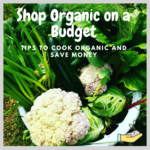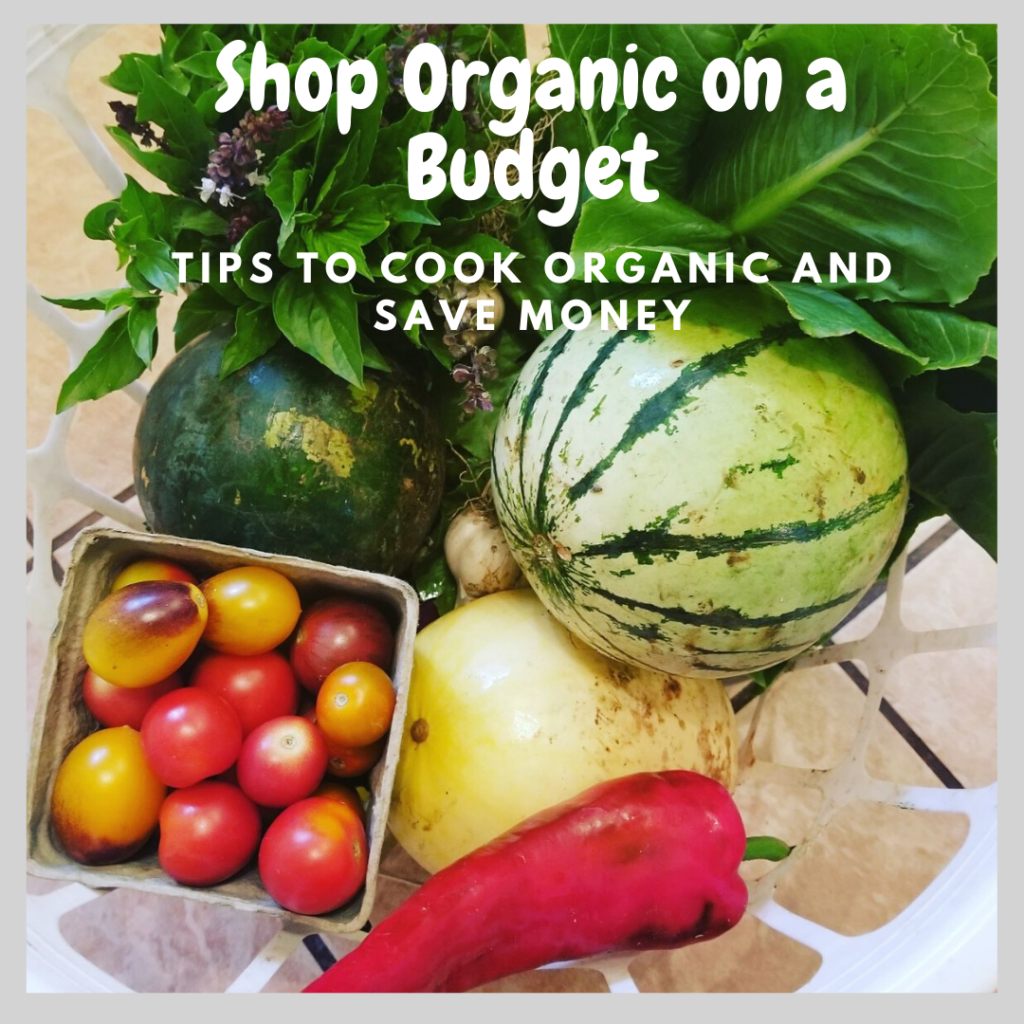
When I talk with friends about shopping and cooking organic the most common refrain I hear is “But organic food is so expensive!” My response is Yes, and No – It’s true that it can be, but it doesn’t have to be more expensive to eat and cook organic. Not only is it possible to buy organic on a budget, the costs of not going organic far outweigh the extra effort it takes to do it.
So first, Why Eat Organic?
This question deserves it’s own blog but it’s worth underlining here that it’s absolutely worth the extra time and effort to eat organic because it’s the easiest, don’t-have-to-worry-about-it way to insure that we’re not eating pesticides or high doses of synthetic hormones and antibiotics. Commonly used pesticides like Glyphosate, Chlorpyrifos and Atrazine are used in conventional agriculture in the United States and scientific studies (and law suits) have shown that eating pesticides carries serious health risks (see above pesticides which are hyperlinked for more information on risks). Organic food is produced without using conventional pesticides; fertilizers made with synthetic ingredients or sewage sludge; bio-engineering; or ionizing radiation. It also means your food won’t have artificial flavorings or coloring and that your baking flour won’t be laced with chlorine, bromates or peroxides (yucky!). In addition Organic meat, poultry, eggs and dairy come from animals that are not given antibiotics or growth hormones.
Shop-Local Options
Local farmer’s markets are fun, they’re a great way to support local farms, spend a weekend morning outside and feel like you’re part of your community. The downside with farmer’s markets is that they tend to be a more expensive way to shop – farmers need to cover their expenses to transport their produce, set up their booths and spend their day in town.
Another great way to support local farms are CSA ( Community Supported Agriculture) initiatives. CSA is a production and marketing model whereby consumers buy shares of a farm’s harvest in advance. Consumers become CSA members by paying an agreed amount at the beginning of the growing season, either in one lump sum or in installments. I signed up for my first CSA last year with Third Way Farms, near where I live in Maryland, and it was wonderful! Prices vary with the farm and the season, but they tend to offer a wide variety of organic produce for less than you’d pay at your local grocery store. My CSA spanned 29 weeks, from May through November and the cost averaged less than $18 per week.

The Great aspects of CSAs:
- Good Value for Good Variety: Less than $20/week bought me a laundry basket of produce that changed constantly but I could count on 5-8 different vegetables each week including staples that are hard to find in the grocery store such as organic garlic and shallots and exotic veggies like Kohlrabi and Japanese radishes.
- Visiting the farm each week was a nice diversion from my normal day, and for me the drive isn’t much farther than my nearest supermarket. City based CSAs work with centrally located pick-up spots, like a neighborhood co-op or health-food store. When I picked up my basket I was able to see people harvesting and washing produce, animals grazing and it made me aware of the very holistic cycle of producing, preparing and eating food. I was proud to be supporting a local organic farm.
- I tried new things and experimented with vegetables that I probably wouldn’t have been exposed to if it weren’t for the CSA because they’re not sold in grocery stores and/or I could easily walk by something unfamiliar at my local farmer’s market.

The Not-Great aspects of CSAs:
- The CSA pick-up is going to be an added trip for your groceries in addition to a trip to your grocery store. My CSA pick-up day is Wednesday, which means that I have to balance not knowing what veggies I have to cook with until Wednesday and my weekly grocery-store trip on Sunday. For someone who likes to plan meals on Sunday this was a challenge for me.
- You really need to cook, otherwise your beautiful organic vegetables are going to rot! I cook six nights a week (Saturday is date night!) so I don’t have a problem using the produce while it’s fresh, but for someone who is just starting to cook at home, or who isn’t used to cooking from scratch, it may make sense to wait before jumping into a CSA.
Discount Supermarkets
Have Lidl or Aldi come to your neighborhood?? These are German owned grocery store chains that have increased their presence in the United States over the last few years (Lidl opened in the US in 2015 and has 70 stores in 9 states and Aldi has been in the US since 1976 and has over 1900 stores in 36 states). They both offer discount prices on high quality foods, including many European brands that I haven’t seen in other American stores. I go to Lidl a couple times a month and while their stock changes regularly I can count on organic staples at much lower prices. Grass-fed organic ground beef, for example is usually under $3/lb, less than half of what I’ve paid for it in high-end grocery chains . Other goodies like organic berries sell for about half what I see in more conventional stores.
Sprouts is a natural-foods chain that started in 2002 with 360 stores in the US . They recently opened a store near me and I can attest that they are significantly less expensive than other natural foods and high-end grocery stores. I’m able to get a week’s worth of groceries, almost all organic products, for less than I’d pay at the conventional grocery chain near me, where I wouldn’t have as many organic choices. Sprouts also has a foundation, founded in 2015, called Sprouts Healthy Communities Foundation, that focuses on giving locally in the areas of food security and hunger relief; promoting health education and nutrition; and helping people living with disabilities and health concerns.
On Line Organic Shopping
Shopping on-line isn’t my first choice, and studies show how shopping close to home has a direct positive impact on our local economies, so I try not to shop on-line for food if possible. But the fact is that there is a big problem in the United States with food deserts – where people are forced to drive long distances for access to a variety of fresh produce and may not even know where they can find organic produce anywhere near where they live and work. For this reason I wanted to highlight Thrive Market in case you’re not already familiar with it – Thrive Market is a socially conscious shopping club (the annual membership is between $50-$60 and fees are waved for families on SNAP benefits which are accepted as payment). They also use carbon-neutral shipping practices with 100% recyclable packaging and zero-waste warehouses. And, their prices are very good, significantly less than an average health food or high-end grocery store. For people who don’t live in large cities Thrive Market is a great source for organic and non-GMO products, from baking supplies to snack-bars to fruit juice to almond-milk!
How Does Eating Organic Save the World?
Organic farms use production practices with environmental benefits such as water management practices, no-till or minimum tillage, habitat maintenance for beneficial insects and vertebrates and biological pest control. These ecologically protective practices contribute to enhanced ecosystem services and benefit water quality, soil health and biodiversity (Find out more at https://ofrf.org/research/organic-faqs/ ). According to Pew Research there were more than 14,000 certified organic farms in the United States in 2016, per the latest available data from the U.S. Department of Agriculture’s National Agricultural Statistics Service. This represents a 56% increase from 2011, the earliest comparable year. As the number of organic farms has increased, so too have sales of certified organic products: U.S. farms and ranches sold nearly $7.6 billion in certified organic goods in 2016, more than double the $3.5 billion in sales in 2011. This progress still only represents a tiny sliver (about 1% ) of agricultural land in the US and switching to organic isn’t easy (there’s a three-year transition period to cleanse the soil from conventional farming, so you’ll now see food labeled “certified transitional”) but farmers do have more incentives than ever to switch to organic farming – this means healthier less toxic, soil and less contaminants running off into our streams and rivers, ponds and drinking water! I call that saving our world in a major way!
I hope this was helpful and that you’re inspired to check out the CSA options in your area, visit a new discount grocery store and make shopping organic part of your routine. Please let me know what you think, I’d love to learn about your fixes for shopping organic on a budget, and lets do this!



